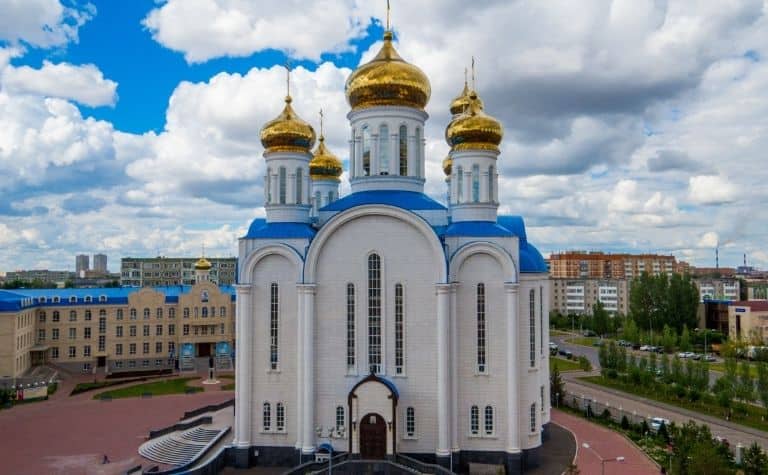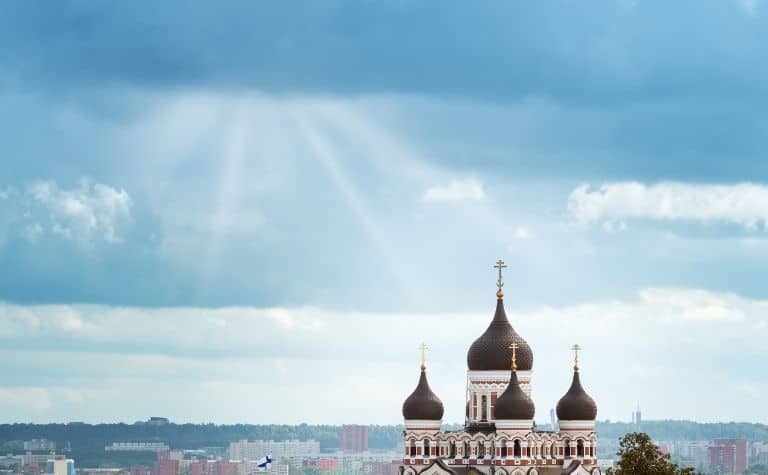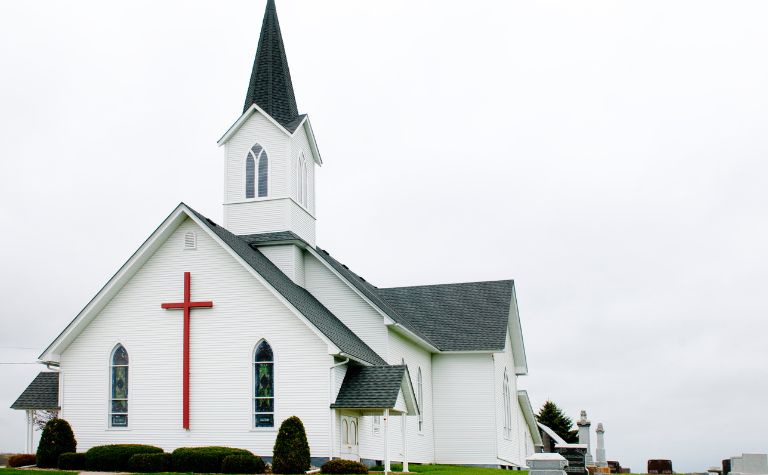Protestantism and Eastern Orthodoxy are two of the three historical branches of the Christian faith, along with Roman Catholicism. Though the Orthodox tradition is approximately 500 years older than Protestantism, similarities exist. There are also important differences.
A key disagreement between the Orthodox and Protestant traditions regards the Holy Spirit. Orthodox theology teaches that the Spirit proceeds from the Father. Protestantism teaches that He proceeds from the Father and the Son, Jesus Christ. There are also other differences between the traditions.
What are the three main differences between Protestantism and Eastern Orthodoxy? How do their origins, Bibles, and membership numbers compare? Why did some Protestants vandalize the sanctuaries of Orthodox churches at the time of the Reformation? Keep reading to learn answers to these questions and more.
Also, see Eastern Orthodoxy vs. Protestantism vs. Roman Catholicism Compared for more.

Protestantism and Eastern Orthodoxy: Similarities and Differences
The Protestant and Eastern Orthodox traditions have many similarities, including belief in the virgin birth of Christ, his physical resurrection from the dead, and his Second Coming. (Also see Protestant vs. Pentecostal: What’s the Difference?)
The traditions also have significant disagreements, which may be summarized in three general points (more details below).
- The procession of the Holy Spirit: Eastern Orthodoxy believes that the Holy Spirit proceeds from the Father alone, and not the Father and the Son, as Protestantism and Roman Catholicism contend. The phrase “and the Son,” also referred to as “the filioque clause,” which is the original Latin term, was inserted in the Nicene Creed in 589 A.D. at the Synod of Toledo, Spain. The Orthodox Church did not participate in the synod and strongly disagreed with the addition.
- The role of the pope: Protestantism does not recognize the authority of the pope. Eastern Orthodoxy honors the pope but does not recognize his authority.
- The recognition of ecumenical councils: Ecumenical councils are meetings that have been held throughout church history to articulate unity of doctrine among Christians. The councils are applications of Jesus’ prayer for unity (John 17:21) and the example of the meeting in Jerusalem as recorded in Acts 15. The early church called councils to discuss important doctrines like the Trinity and Christology. Protestantism recognizes many beliefs expressed in the councils. Roman Catholicism recognizes 21 councils. Eastern Orthodoxy recognizes the first seven, which occurred from the 4th to 8th centuries.
| Protestantism | Eastern Orthodox | |
|---|---|---|
| Origin | Protestantism was born in 16th-century Europe, centered in Germany, and under the reforms of Martin Luther (1483-1546). | In 1054 A.D., about 500 years before the Protestant Reformation, a split occurred between the Eastern and Western churches. The division is commonly referred to as the East-West schism. |
| Meaning of the name | The word “Protestant” comes from the Latin word protestari, meaning “to bear witness.” | “Eastern” referred to the geographical area of the Orthodox tradition, whose capital was Constantinople. The “Western” church referred to Roman Catholicism, whose capital was Rome. “Orthodox” comes from a Greek word meaning “correct belief.” |
| Approximate membership | 1 billion worldwide | 220 million worldwide |
| Early influencer | Martin Luther, John Calvin of France (1509-1564), and Ulrich Zwingli of Switzerland (1484-1531) | Patriarch Michael I Cerularius of Constantinople (1000-1059); the Three Pillars of Orthodoxy: Photios I of Constantinople (810-893), Mark of Ephesus (1392-1444), and Gregory Palamas (1296-1359) |
| Significant writing outside the Bible | The Apostles Creed, the Nicene Creed; the writings and sermons of Martin Luther, especially the 95 Theses, Calvin’s The Institutes of the Christians Religion; many others | The teachings of the first seven ecumenical councils of the church from the 4th to 8th centuries; the Apocrypha or Deuterocanonical literature; the Septuagint, a Greek translation of the Old Testament; the Peshitta, a Syriac translation of Bible |
| What are the largest denominations in the tradition today? | Southern Baptist Convention, the United Methodist Church, the Evangelical Lutheran Church of America, and the Assemblies of God | Eastern Orthodox are commonly referred to as national churches, not denominations. The largest are The Russian Orthodox Church, the Romanian Orthodox Church, the Greek Orthodox Church, and the Serbian Orthodox Church. |
Are Protestant and Eastern Orthodox Christians divided today? Although the Protestant and Eastern Orthodox traditions do not have the divisive history that the Orthodox church does with Catholicism, many theological and ecclesiastical disagreements exist between them.
Certain Orthodox leaders, however, have expressed unity on matters that are of concern for each tradition today, such as the breakdown of the family. [1] (Also see Protestant vs. Anglican: What’s the Difference?)

Protestantism and Orthodoxy: Beliefs and Practices Compared
| Protestantism | Eastern Orthodox | |
|---|---|---|
| Scripture | One of the hallmarks of the Protestant tradition is the authority of Scripture over and above church tradition. Protestants historically believe in the inspiration and authority of Scripture. “Sola Scriptura” refers to the Protestant belief that Scripture is sufficient and authoritative to know how to be saved and live a life that pleases God. | The Bible is the source of doctrine and practice in Eastern Orthodoxy. The Orthodox Church does not hold to Sola Scriptura because it believes the church defines Scripture and determines its meaning. [2] |
| God | Protestants believe in the Trinity, one God who exists in three persons: the Father, Son, and Holy Spirit, are each fully divine. | Eastern Orthodoxy believes that God is Triune, but unlike Protestantism, it does not believe that the Holy Spirit proceeds from the Father and Son, but only the Father. |
| Christ | Jesus is the second person of the Trinity. He is God in human flesh. He is 100% God and 100% man. Jesus was born of a virgin, lived a sinless life, died as a substitutionary atonement for sin, and was physically resurrection on the third day. | The second person of the Trinity became a man in the person of Jesus of Nazareth, according to Orthodox beliefs. Jesus was virgin-born and lived a sinless life. Orthodoxy rejects the Protestant belief that his death on the cross was substitutionary. The Orthodox Church affirms the historical, physical resurrection of Christ from the dead. |
| Salvation | Protestants believe that salvation is by grace through faith in Christ alone. Protestants can be Arminian, Calvinist, Baptist, or something else. | The Orthodox view of salvation is based on 2 Peter 1:4 (see below) called “deification,” which refers to a process of becoming more like God. Deification does not mean that believers will become exactly like God in his essence. |
“Through these he has given us his very great and precious promises, so that through them you may participate in the divine nature, having escaped the corruption in the world caused by evil desires.” (2 Peter 1:4, ESV)
Also, see Protestant vs. Evangelical: What’s the Difference?

| Protestant | Eastern Orthodoxy | |
|---|---|---|
| Baptism | Generally, Protestants believe baptism identifies a person with the death and resurrection of Christ (Rom. 6:3-5) and obedience to Christ. It also signifies their inclusion into the church community (Acts 2:38-47). Protestants do not agree about who (children or adults) should be baptized and how (sprinkling or immersion). | Bishops and priests administer baptism, in which subjects are immersed three times, one for each member of the Trinity. Eastern Orthodoxy teaches that baptism regenerates a person and makes them a member of the true church. |
| Communion | Generally, Protestants believe the Lord’s Supper is a continual practice that Christ started before his death and resurrection. Protestants don’t agree about the nature of the bread and cup. | The Orthodox Church teaches that the bread and cup literally turn into the body and blood of Christ, but it does not attempt to explain exactly how it occurs. |
| Icons | Protestants do not have a tradition of using icons to aid their worship or increase their devotion to God. At the time of the Protestant Reformation, some involved in the reform movement participated in destroying icons, believing that they violated the second commandment (Exod. 20:4). | An icon is a physical representation of a holy person or thing. The Eastern Orthodox tradition, throughout its history, has strongly defended the use of icons, which they believe enhance people’s devotion to God. |
| Holy Spirit | The Holy Spirit is the third person of the Trinity. He is fully divine. The Spirit applies the salvation that the Father planned and that the Son earned for sinners. He bestows spiritual gifts on believers that they are to use for the edification of the Church. | The Holy Spirit is the third person of the Trinity and is fully God, according to Orthodox teachings. The Spirit is distinct from the Father and the Son. “Christ sends the Holy Spirit who proceeds from the Father.” [3] |
| The Return of Christ | Protestants believe in the Second Coming of Christ, which is a core belief in the tradition. | Eastern Orthodoxy believes in the return of Christ but does not have a fully developed eschatology as Protestantism does. This is due in part to the Orthodox Church’s belief that the book of Revelation is a mystery. |
| Millennium | Protestant churches may be Premillennial, Postmillennial, or Amillennial. | The millennial is not a focus of Orthodox theology. Orthodox theologians that have expressed beliefs on the topic reflect Amillennial views. |
Also, see Protestant vs. Baptist: What’s the Difference?
Please see the related articles below.
References:
[1] Source
[2] Source
[3] Source
Related Articles
Catholic vs. Protestant vs. Orthodox: What's the Difference?
Roman Catholicism, Protestant Christianity, and the Eastern Orthodox Church are the three historical branches of the Christian religion. Each tradition traces its doctrines and practices to the New...
Protestantism and Anglicanism are branches of the Christian faith that have roots in Europe. Protestantism and Anglicanism have similarities and differences with each other as well as other...
